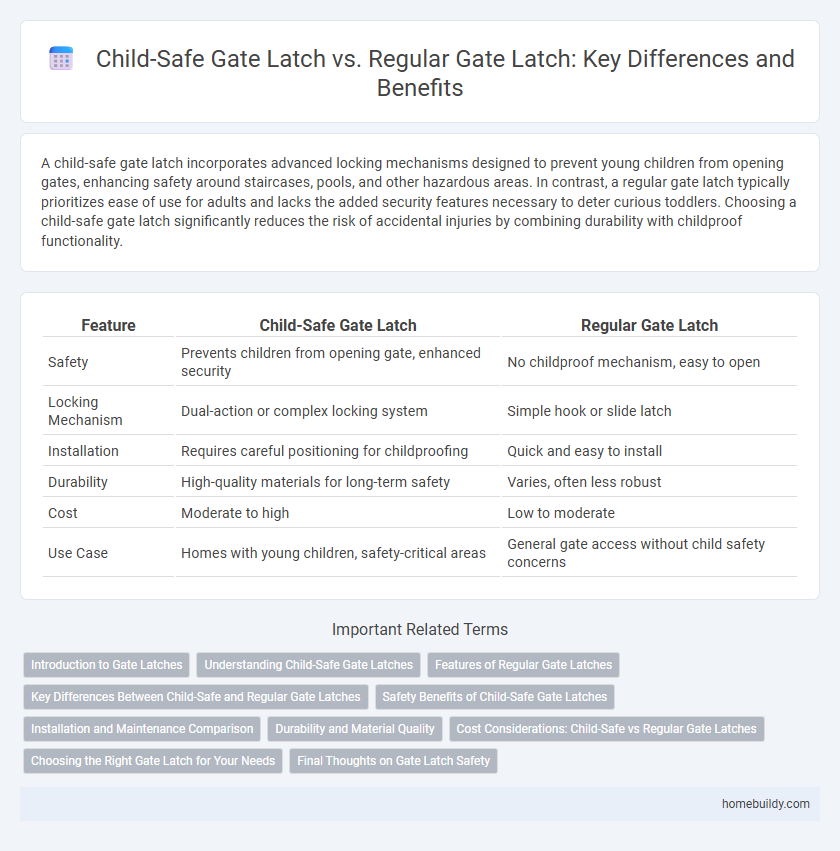A child-safe gate latch incorporates advanced locking mechanisms designed to prevent young children from opening gates, enhancing safety around staircases, pools, and other hazardous areas. In contrast, a regular gate latch typically prioritizes ease of use for adults and lacks the added security features necessary to deter curious toddlers. Choosing a child-safe gate latch significantly reduces the risk of accidental injuries by combining durability with childproof functionality.
Table of Comparison
| Feature | Child-Safe Gate Latch | Regular Gate Latch |
|---|---|---|
| Safety | Prevents children from opening gate, enhanced security | No childproof mechanism, easy to open |
| Locking Mechanism | Dual-action or complex locking system | Simple hook or slide latch |
| Installation | Requires careful positioning for childproofing | Quick and easy to install |
| Durability | High-quality materials for long-term safety | Varies, often less robust |
| Cost | Moderate to high | Low to moderate |
| Use Case | Homes with young children, safety-critical areas | General gate access without child safety concerns |
Introduction to Gate Latches
Child-safe gate latches incorporate advanced locking mechanisms designed to prevent young children from opening gates, enhancing safety around stairs, pools, and play areas. Regular gate latches offer basic functionality focused on securing gates without specific safety features to deter tampering by children. Understanding the distinction between these types is crucial for selecting gate hardware that prioritizes household safety and accessibility.
Understanding Child-Safe Gate Latches
Child-safe gate latches feature complex locking mechanisms designed to prevent young children from opening gates, reducing the risk of accidents around stairs or pools. Unlike regular gate latches, which often rely on simple manual release systems, child-safe models require coordinated actions such as pressing buttons or lifting levers, ensuring enhanced security. These latches comply with safety standards like ASTM F1004, providing peace of mind for parents and caregivers concerned about childproofing environments.
Features of Regular Gate Latches
Regular gate latches typically feature a simple mechanism such as a sliding bolt or hook and eye design, providing straightforward access without complex locking. They are made from durable materials like steel or aluminum, ensuring weather resistance and longevity in outdoor environments. Unlike child-safe gate latches, regular latches lack advanced safety features such as dual-action release or keyed locks, making them less secure for households with young children.
Key Differences Between Child-Safe and Regular Gate Latches
Child-safe gate latches incorporate advanced locking mechanisms, such as dual-action releases or magnetic locks, to prevent young children from opening gates, unlike regular gate latches that typically rely on simple manual locks. Materials used in child-safe latches often meet safety standards for non-toxic finishes and rounded edges, enhancing protection against injury. Child-safe designs prioritize ease of adult use while maximizing resistance to accidental opening or tampering by toddlers, contrasting with regular latches which may lack these security features.
Safety Benefits of Child-Safe Gate Latches
Child-safe gate latches provide enhanced safety by incorporating locking mechanisms that are difficult for young children to open, reducing the risk of accidental falls or access to hazardous areas. Unlike regular gate latches, child-safe models often require simultaneous pressing or squeezing actions, which are intuitive for adults but challenging for children to manipulate. This increased security helps prevent injuries and offers peace of mind for parents and caregivers.
Installation and Maintenance Comparison
Child-safe gate latches often require more complex installation processes, involving multi-step locking mechanisms to ensure child security, whereas regular gate latches typically feature simpler, single-action installation. Maintenance for child-safe latches demands frequent inspections and adjustments to maintain safety standards and prevent malfunction, while regular latches generally need less frequent upkeep due to their straightforward design. Both types benefit from lubrication and hardware tightening, but child-safe latches prioritize operational reliability and safety compliance.
Durability and Material Quality
Child-safe gate latches are engineered with high-grade, impact-resistant materials such as reinforced polypropylene or stainless steel to ensure durability under frequent use and enhance safety against tampering. Regular gate latches often utilize basic metal alloys or plastics that may corrode or weaken over time, compromising longevity and security. Advanced corrosion resistance and sturdy construction in child-safe latches provide superior reliability in both indoor and outdoor environments.
Cost Considerations: Child-Safe vs Regular Gate Latches
Child-safe gate latches typically cost 30% to 50% more than regular gate latches due to advanced safety mechanisms preventing accidental openings. Material quality and design complexity contribute to the higher price, ensuring enhanced protection for children. Investing in child-safe latches can reduce long-term expenses related to accidents or damages caused by unsecured gates.
Choosing the Right Gate Latch for Your Needs
Choosing the right gate latch depends on safety requirements and usage context; a child-safe gate latch incorporates secure locking mechanisms that prevent children from accidentally opening the gate, making it ideal for homes with young kids or pets. Regular gate latches provide basic access control without specialized safety features, suitable for adult-only environments or areas with low risk of unintended gate opening. Prioritize child-proof latches if safety is a primary concern to ensure maximal protection and peace of mind.
Final Thoughts on Gate Latch Safety
Child-safe gate latches incorporate advanced locking mechanisms designed to prevent young children from accidentally opening gates, significantly reducing the risk of injury or unauthorized access compared to regular gate latches. These safety features often include complex release systems requiring simultaneous actions, making them effective barriers for toddlers and young children. Investing in a child-safe gate latch enhances overall security and peace of mind, especially in households with active children or pets.
child-safe gate latch vs regular gate latch Infographic

 homebuildy.com
homebuildy.com